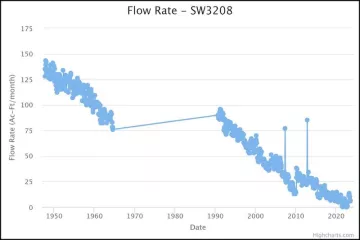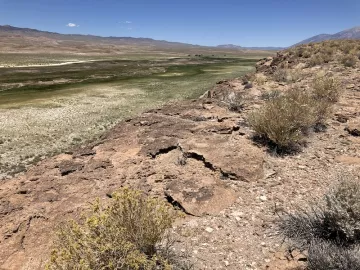
The flow gauge at the Northeast Spring in Fish Slough was 0.67 acre-feet/month on June 1, 2022 and hit zero by July 1. This was the first time since the first gauge reading in 1947 that the spring has dried up. It started flowing a little again that winter. In the 1940s the flow rate was in the 130-140 af/m range. It dropped to under 100 in the 1960s and has been in steady decline since. It was 5.98 af/m last September 1, 2023. The Northeast Spring is the biggest of three springs that feed Fish Slough, but they have all been drying up. Groundwater levels have also been declining in the Tri-Valley by 0.5-2 feet/year for the past 20-30 years. A 2019 isotope study showed that the Northeast Spring has a strong signature for water coming from the Tri-Valley mixed with water from the Tablelands and Adobe Valley.
To identify the cause of the decline in the springs at Fish Slough and to sustainably manage the groundwater in the Tri-Valley area, Mono County secured a grant to develop a hydrological model of the Tri-Valley groundwater sub-basin, which includes Fish Slough. The Inyo County Water Department has prepared a Request for Proposal (RFP) to hire a hydrologist to prepare the model and to do a second isotope study. The RFP needs to be approved by the County and hopefully, will go out this July. Two deep monitoring wells are scheduled to be put in Hamill Valley on BLM land by the California Department of Water Resources (DWR) this July as well that will provide much needed data of the groundwater levels there. Important information for the hydrologist will also come analyzing the strata that will be drilled through and data from DWR's recent Airborne Electromagnetic survey flight over the Tri-Valley.

It is a race for time to get a better understanding of the groundwater flow in the Tri-Valley before Fish Slough's unique ecosystem dries up and we lose the aquatic and plant species dependent upon the springs. Fish Slough is an important desert wetland that was designated a National Natural Landmark in 1975 and an Area of Critical Environmental Concern in 1982.